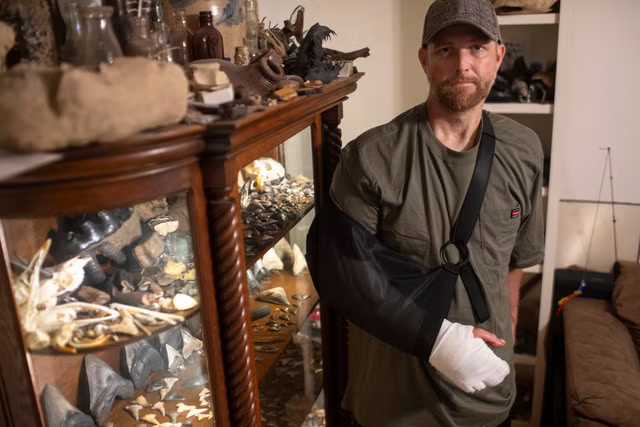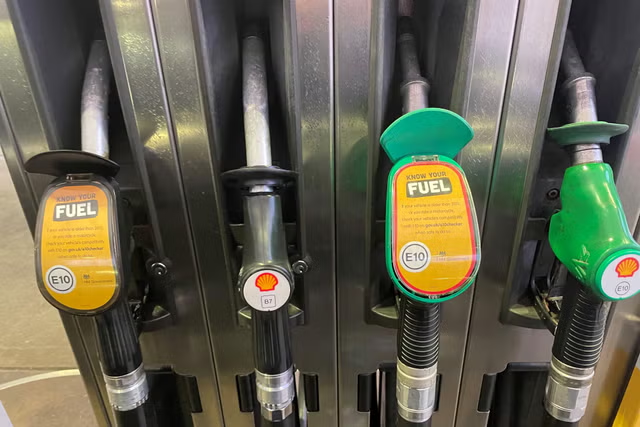In the last four years I’ve hiked 1,200 miles, I’ve swum 1,600 miles, rowed 2.2 million metres on an indoor machine, I’ve qualified as a yoga instructor, and I’ve travelled around Australia for six weeks. But none of this would have been possible without my stoma bag.
And yet when it was first suggested to me 10 years ago, aged 38, I couldn’t stop crying because it seemed like the most awful thing in the world. There is so much stigma surrounding them, people think they smell and are dirty. I was no different, the idea of my life stretching out in front of me with this embarrassing secret was horrendous. But after two decades of problems with my bowel I realised it was the solution I had to face up to.
My problems with incontinence all started a year after the birth of my son. I’d suffered what I had believed to be a second degree tear, I was patched up and sent home. But when he was two, I underwent mesh surgery to help with bladder control. Three months after that, I developed problems controlling my bowel. I was in my 20s and fitness mad, juggling a career and a young child but things just got worse as the years went on. I saw specialist after specialist and had 19 operations over a 20-year period. I kept being told things would improve but they didn’t.

Being incontinent is as mortifying as you would imagine. As well as the physical agony, there were the stress-filled trips on public transport panicking I wouldn’t make the loo. I’ve dashed into bushes when caught short and of course there’ve been accidents. I met my husband Andy when Blake was four, and having to explain, in a new relationship, that I was faecally incontinent wasn’t great. He was, and still is, my absolute rock.
Life revolved around the lavatory for years. I would need the loo up to 13 times a morning, not because I had diarrhoea but because the mechanical function in my sphincter muscles didn’t work to clear my bowel. Faecal incontinence makes you feel unclean.
In 2019, when I knew I’d exhausted every avenue and been under the care of several consultants at different hospitals, I finally accepted that having a stoma bag fitted was the best option. There are around one in 330 people in the UK who have a stoma bag, meaning they are unable to pass stools through their anus – the reason could be because of illness, a digestive system problem or because of an injury, as I had.
I underwent the operation to have it fitted that December. At first it felt strange having something next to my skin constantly, and I had to miss out on many of the festive foods with dried fruit, such as mince pics and Christmas cake that year, while I worked out what foods agreed with me. But the physical recovery was straightforward.

Andy even gave my stoma a nickname, “Anemone” because it looks like a little sea creature. Of course I worried about how he would feel towards me initially. Will he still fancy me? But we found that sex wasn’t a problem. We even joke together about any rustling noise when we’re in bed. Having a sense of humour does help.
It was Andy who encouraged me to wear a bikini and not hide away on the beach. I do sometimes get funny looks when my stoma is on display, and people approach me but I’m happy to talk about it and how I live with it. There’s an assumption that it must be temporary. “When are you getting it reversed?” I’m asked. I just explain that having it reversed would put me back to where I was: incontinent and unhappy.
I’ve had mean comments over the years. After I first had the operation, an agency nurse was hurtful; when I asked her to stay with me as I’d never changed a bag before, she replied “I’ll try not to be sick”. There’s revulsion with stoma contents.
Stomas have their problems: 70 per cent of people get a parastomal hernia (when loops of intestine bulge through weakened abdominal muscles behind the stoma) within the first two years, which may require revision surgery. They can also leak, but I’ve found this is less likely if you find the right bag for you, it’s trial and error. And I still have to manually clear my rectal mucus daily because my rectum still acts like there’s stool there.
There are no rules with stomas as everyone’s experience is different. Personally I avoid things that induce gas – such as cabbage and chickpeas – as it makes the bubbling noises and causes discomfort by creating a pocket of air and “ballooning,” effectively looking like you have a zeppelin stuck to your body.
I don’t eat lots of red meat and I’m meticulous about chewing so I don’t get a blockage, which might need surgically removing. The skin around the stoma needs proper care so I use special soft wipes to clean it. Because I exercise and swim regularly, I change my bag two to three times a day. I have what they call a “closed bag” so I change the whole thing whereas others have a drainable bag, which is emptied of contents and the same bag is kept for longer.

I have a radar key for accessible loos when I’m out, because regular cubicles don’t have sinks which I need for hygiene. Because I don’t “look disabled” I’ve been challenged everywhere from garden centres to theatres. Someone had a real go at me once pointing out I wasn’t in a wheelchair, and I snapped back: “You can’t see I’ve got bowel incontinence!”
There are times when it makes funny bubbling noises sometimes, which used to make me squirm in embarrassment, and Andy gallantly pipes up “excuse me,” but I’ve learnt to mind less. It’s no worse than farting, it’s just another bodily function. When I climbed the Welsh Three Peaks last year, all the public lavatories were shut, meaning I had to change my bag at the side of the road. You have to make do sometimes.
I’m lucky as it doesn’t tend to need changing in the night, and I can lie on my front without worrying about leaks. I choose high waisted knickers, trousers and special sportswear. Although I dreaded the idea of a stoma when it was first suggested, it’s meant that I’ve been able to take up competitive swimming, row in charity challenges, hike, and climb mountains. I’m climbing Kilimanjaro in October 2025, in a team where half of us have stomas, to fundraise for Chameleon Buddies, a charity supporting women and girls in Kenya who have stomas following birth injuries.
In hindsight, I wish I had Anemone sooner because she’s given me freedom. So when people ask when it’s being reversed I smile and say it’s for life because I don’t want to waste any minute of it any more.
As told to Susanna Galton
If you’re worried about a stoma-related problem you are not alone, Colostomy UK has a 24 hour helpline.
Jo is climbing Mount Kilimanjaro for women and girls who need better stoma facilities in Kenya if you would like to donate to her Just Giving page.
Disclaimer: The copyright of this article belongs to the original author. Reposting this article is solely for the purpose of information dissemination and does not constitute any investment advice. If there is any infringement, please contact us immediately. We will make corrections or deletions as necessary. Thank you.



